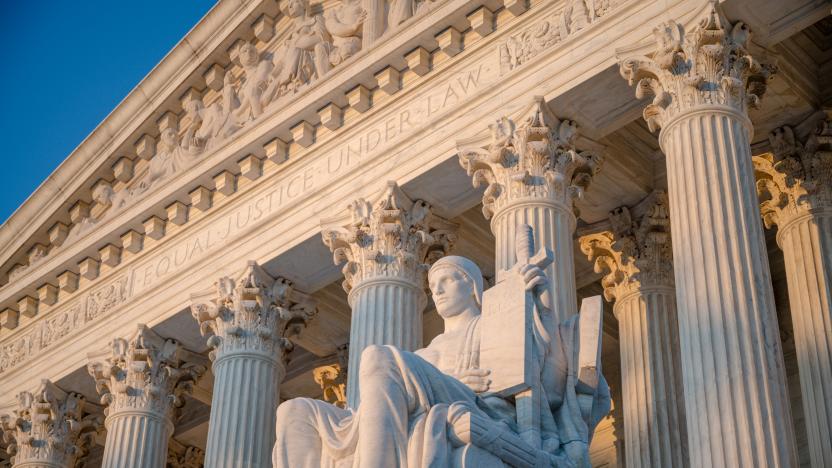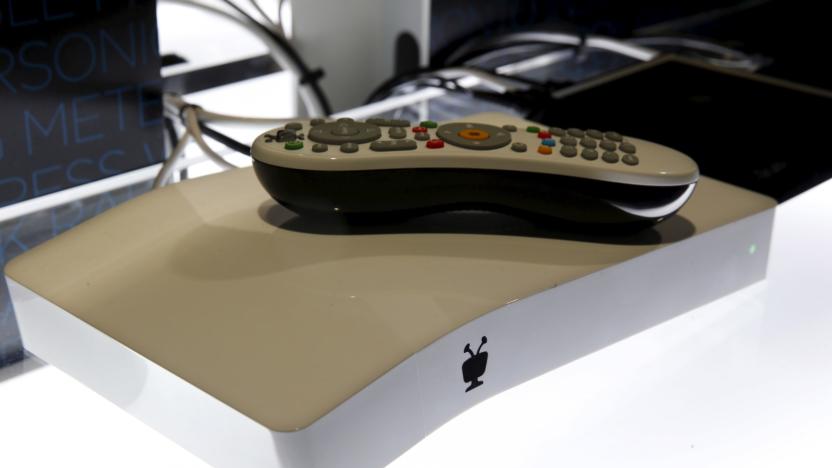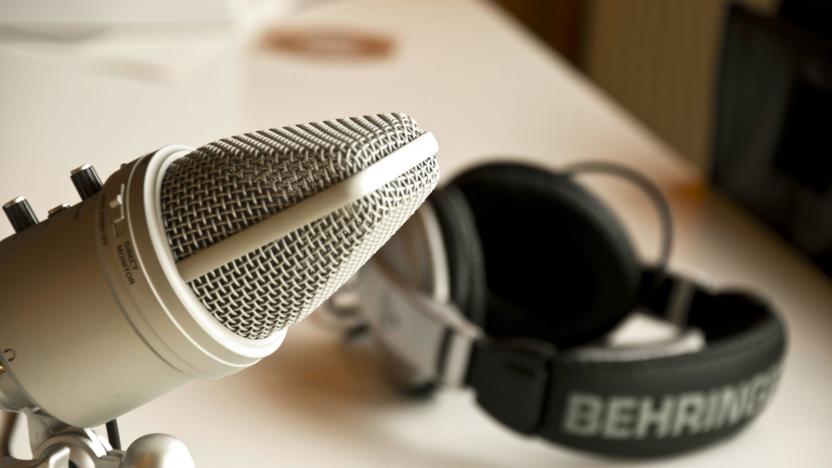uspatentandtrademarkoffice
Latest

Supreme Court rules generic website names can be trademarked
Justices determined in an 8-1 ruling that Booking.com is eligible for a trademark.

TiVo wins one of its patent fights with Comcast
TiVo has good news going into the holiday season: The International Trade Commission (ITC) has ruled that Comcast's X1 set-top boxes violate two of TiVo's patents related to setting recordings from a mobile device. As a result, there's now an import ban on "certain" X1 boxes that violate the patents, but older models won't be affected, Reuters reports. An import ban would mean that offending gadgets that've already been brought into the country can't be sold. This ban could be overturned by the Trump administration during the presidential review period. Bloomberg writes that that sort of thing happening is a pretty rare occurrence.

Federal court steps in to protect podcasts from patent troll
The venerable podcast is the bastion of broadcasters big and small, from major news outlets to DIY publishers. But, for the last few years, this hallowed ground has come under threat from patent troll Personal Audio -- which has tried to sue podcasters of all sizes. It claims it created the concept of the podcast. Thankfully, the U.S. Court of Appeals disagrees. A three-judge panel of the court just affirmed a previous decision rendering Personal Audio's patent invalid. The ruling declares the company was trying to protect an invention that already existed. Meaning podcasters and listeners can rest easy, for now.

Former Google lawyer Michelle Lee will run the US patent office
It's official: after four months of waiting, former Google legal counsel Michelle Lee has been confirmed as the head of the US Patent and Trademark Office. She was already serving as the acting director (the position has technically been vacant since 2013), but this gives her a more secure footing. The nod is potentially a big help to the agency. While there have been steps to curb patent trolling, a more permanent USPTO position could help Lee improve the quality of US patents and discourage frivolous lawsuits. She was already a vociferous advocate for patent reform in her Google days, and she now has a solid platform for making those reforms a reality. [Image credit: Tony Avelar/AP Images for SanDisk Corporation]

US patent office throws out Apple's pinch-to-zoom claim against Samsung
For those of you eagerly following the seemingly never-ending legal battle between Apple and Samsung (cue crickets), a recent decision by the US Patent and Trademark Office has thrown a wrench into Apple's master plan. According to documents filed by Samsung in the United States District Court for the Northern District of California on Sunday, Apple's Patent No. 7,844,915, which covers the two-finger pinch-to-zoom gesture, was found wanting by the USPTO due to it being anticipated by other patents and declared otherwise non-patentable, much like its "overscroll bounce" claim. Apple has up to two months to dispute the decision, though whether or not that action would gain the company any ground, either with federal court or the Patent Trial and Appeal Board, remains to be seen.

Apple receives patent rights for original iOS Maps app GUI
The US Patent and Trademark Office awarded Apple a patent that covers a "touch screen device, method and graphical user interface" for the iOS Maps application. US Patent No. 8,302,033 describes features in iOS Maps including an easy-to-use UI that did away with pushbuttons and complex menu systems. It also describes functions like pushpin-style bookmarking that is used to mark locations, the use of a pinch-to-zoom gesture to zoom in on a map and cellular connectivity to deliver map data on the fly. Apple's Maps application has been widely criticized after the company recently switched away from Google to its own mapping solution. The new iOS 6 Maps app is not as detailed as previous Google-backed Maps and, in some cases, is ridiculously wrong. The controversy over Apple's Map application expanded beyond upset customers and allegedly led to the removal of iOS software head Scott Forstall. [Via Apple Insider]

Samsung files patent for auto-generating life diary, Mayans didn't see it coming
If the minutiae of people's lives crowd your feeds and drive you to frustration, you really won't be wanting this Samsung patent application to be approved. The USPTO filing outlines a process for creating a "life diary" by collecting all manner of information about your daily routine from your smartphone. Data such as where you've been, what the weather was like, what you've been listening to, et cetera, would be spun out in computer-generated sentences and compiled into a story of your day. Although it would lack the romanticism of a traditional, hand-written diary, we could see it having some use as a mundane log -- as long as you're happy for all that info to be recorded, that is. However, if this ever comes to fruition with sharing options, to boot, all the pictures of food, coffee house check-ins and FarmVille updates would seem insignificant in comparison. Some things, like the last time we sang along with the Bieb, are better left unshared.

RIM continues its fuel cell streak, applies for two more patents
Looks like RIM is more interested in fuel cell technology than we thought: the BlackBerry maker has just applied for two closely related patents for including a fuel cell in an electronic device, one for the frame and one for the fuel tank itself. Although the primary aim of either patent is to show how to fit a fuel cell into the tight space of a mobile gadget, they do show a more rectangular and modern device chassis than the last patent we saw, which had more than a slight whiff of the classic BlackBerry about it. Neither application is necessarily a roadmap for the future, and they don't mean your next BlackBerry smartphone will need top-ups of lighter fluid or methanol every few weeks. Still, they hint that fuel cells are at least somewhat more than a passing fancy in Waterloo.

Nintendo patent application tech tracks your DS from above, serves as tour guide
Nintendo is already guiding you through the Louvre with a 3DS, but a newly published US patent application takes that kind of tourism to a very literal new level. Legend of Zelda creator Shigeru Miyamoto's concept describes a way to direct lost tourists by beaming position information through an overhead grid of infrared transmitters to a mobile device (portrayed as a DS Lite) held by the confused visitor below. The handheld then talks wirelessly to a server that lights up floor displays with maps and directions, and a helpful app on the device lets visitors pick their route while they read up on sightseeing tips. Like with any patent, there's no certainty that Nintendo will act on the idea and start wiring up museums with IR blasters, but the January 2012 patent may still be fresh in a frequently inventive mind like Miyamoto's.

Apple patents Siri-like system for controlling cameras, PMPs through a computer or smartphone
"Siri, turn on the flash and take three pictures with my camera after waiting two seconds." Apple's intelligent voice control system has been wildly popular amongst consumers in the U.S., and abroad, but Siri could be making her way to other devices in the future, including iPods, cameras and other consumer electronics. "Okay, Rock God, I will take your picture in two, one..." A patent by Apple filed in 2010 but published today describes a scenario in which you could control a secondary electronic device using your voice, with all of the backend processing passing through a connected smartphone or computer. According to the patent: One embodiment may include a first electronic device communicatively coupled to a server and to a second electronic device. The second electronic device may be a portable electronic device, such as a digital media player, that includes a voice user interface. The second electronic device may be capable of accurate speech recognition, but may not include additional computation hardware and/or software for training the speech recognition engine. As such, the bulk, weigh, and cost for manufacturing the second electronic device may be reduced, resulting in a more portable and affordable product.In other words, you could have Siri-like control of virtually any device, with all of the required hardware and software residing on an iPhone or MacBook, linked with other devices over WiFi or Bluetooth. Voice control wouldn't be practical in all situations, but it could be enormously helpful for certain operations, like adjusting settings or reviewing images. Instead of scrolling through hundreds of images, you could simply say "Siri, show me pictures from last Thursday," and see exactly the shots you were searching for. As always, this is one of thousands of Apple patents, and it quite possibly may never come to fruition as described. But here's to hoping it will. "Siri, show our readers the patent application" -- you'll find it at the source link below.Update: Well, it looks like we missed the mark a little bit here, as this is a patent application, not a granted patent. It's for a voice control system where a device receives voice commands and turns them into text using a speech-recognition algorithm received from a remote server -- which sounds an awful lot like Siri.

Apple files patent for interactive 3D interface, keeps rumor mills turning
Murmurs of an iPad 3 on the horizon not doing it for you? How about a new pseudo-3D interface? A patent filing has whet our appetites with the possibility (that's what it is; a possibility) of a future Apple device capable of gauging depth and displaying a 3D environment based on the user's eye movement. On-screen content would adjust to your eye movement, expanding items where ever your eyesight falls. It would also create a "virtual 3D operating system environment," where the user would feel like the UI projects beyond the two-dimensional screen. The patent includes details on 'realistic' drop shadows for icons and other OS furniture based on the degree and angle of ambient light. The filing, from April 2010, says that the technology would use an accelerometer, GPS and 'gyrometer' to reference the placement of the device and report on its movements. Sound interesting? Those in need of more foggy details and line drawings can hit up the full patent request at the source below.

Sony Xperia Sola appears at US Patent Office, forgets to mention its codename
So far, the extent of Sony's 2012 smartphone portfolio for the US extends only to the AT&T-bound Xperia Ion, with no word just yet whether the see-through banded Xperia S will arrive on American shores. What happens if it was called the Xperia Sola? That very name's showed up at the US Patent and Trademark Office, although that's largely it. So it could be a phone we've already seen, or perhaps one of those many road-mapped pseudonyms. Well, with a certain big mobile event just around the corner, we're sure to get a few more answers on Sony's other plans for the New World later this month.

US Senate passes patent system reform bill, Obama expected to sign into law
Think it's time to change our patent system? So does Congress. Yesterday, the Senate approved the America Invents Act by an 89-8 vote that could bring about the most drastic changes to the US Patent and Trademark Office (USPTO) in five decades. Under the bill, which the House approved back in June, patents would be awarded not to the first person to invent a technology, but to the first one to actually file with the USPTO, bringing US policy in line with protocol adopted in most other countries. It also calls for a streamlined application process and would allow the USPTO to charge set fees for all apps. The revenue generated from these fees would go directly to a capped reserve fund, allowing the office to retain the lion's share of the money, rather than funneling much of it to Congress, as had become the norm. Supporters say this extra revenue will give the USPTO more power to chip away at its backlog of some 700,000 patent applications, while a new third-party challenge system will help eliminate patents that should've never received approval in the first place. Opponents, meanwhile, criticized the bill for not eliminating fee diversion altogether (an amendment that would've placed more severe restrictions was ultimately killed, for fear that it would jeopardize the bill's passage), with Washington Democratic Senator Maria Cantwell questioning the legislation's impact on small businesses, calling it "a big corporation patent giveaway that tramples on the rights of small inventors." But Senator Patrick Leahy, a Vermont Democrat who sponsored the bill, argued that yesterday's approval marks a major and historic inflection point in US patent policy: The creativity that drives our economic engine has made America the global leader in invention and innovation. The America Invents Act will ensure that inventors large and small maintain the competitive edge that has put America at the pinnacle of global innovation. This is historic legislation. It is good policy. The America Invents Act will now make its way to President Obama's desk, where it's expected to receive his signature. For more background on the legislation, check out the links below.

Apple patent application reveals plans for external battery pack, spells further trouble for HyperMac
Way back in September of last year, Apple filed a patent-infringement suit against HyperMac, the folks behind these external batteries. At the time, it looked like Apple was protecting its patented MagSafe power connector, but a newly released USPTO application for a "Power Adapter with Internal Battery" might reveal a more accurate view of the company's litigious motivations. From the look of things, the outfit intends to make its mark on juicing solutions with what is basically a wall charger packing an internal battery. According to the patent filing, the contraption would include a processor for parceling energy to the host device as well as the adapter, and could also incorporate a supplemental energy source like a solar cell. Among other things, it would also communicate with the device being charged to allow users to monitor the juice stored in the extra battery. If the thing does end up making it to market, it looks like HyperMac could have a whole lot more trouble on its hands than a little patent-infringement suit.

Apple patent app may mean future unibodies get woven from carbon fiber
Ask any motorsport enthusiast and they'll tell you that there's just something about the way a carbon fiber weave ripples in the sunlight that makes them want to cover every surface of their vehicles with the stuff. It looks like Apple engineer Kevin M. Kenney shares a similar passion, applying for a patent called simply "Reinforced Device Housing" that describes a way for various weaves to be backed by carbon "spine" to provide greater torsional rigidity -- to keep you from twisting it and cracking an LCD. It's hard to deny the images attached to the application look an awful lot like an iPad, but the patent text is rather more broad: Embodiments may house any number of electronic components. For example, certain embodiments may be used to form the exterior surface of a mobile telephone, a laptop or notebook computer, a tablet computing device, a desktop computer, a television, a stereo receiver, or practically any other electronic device. Even sporks and shipping containers are mentioned! We've certainly seen the stuff in some pretty interesting places in the past, and now can't wait to see where it shows up next. %Gallery-107862%

Rambus and NVIDIA patent dispute gets a little closer to a resolution
We're just a few tech-related legal cases away from changing our name to Enpatent, and the latest to push us that little bit closer is yet another ruling in the long and drawn-out battle between Rambus and NVIDIA. If you need a refresher, way back in 2008 Rambus accused NVIDIA of illicitly using five of its patents, and most recently a judge ruled that only three of those five had been violated. Now two more patents have fallen off the legal wagon, with the US Patent and Trademark Office indicating that only one of the three remaining was a true violation, a second was rejected, and a third got a mixed ruling. So, from a start of five Rambus is down to basically one and a half, but NVIDIA is saying it isn't done yet, planning yet another appeal. Maybe we should call ourselves Enappeal instead...











